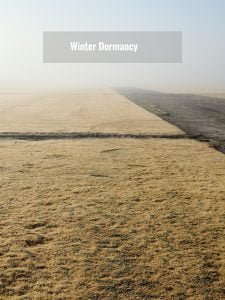Why is Some Grass Green in the Winter, and Some Grass Not?

It’s the time of year again to begin doing yard work, getting our outdoor spaces ready to enjoy as we move into warmer weather. Mild warm weather is short-lived in Texas, so most of us try to get a jump start on our yard preparations as early as we can so that we can begin to enjoy our outdoor recreations as much as possible before the unbearable heat moves in.
One of the most common questions we are asked here at The Grass Outlet is, “When is the best time of year to plant sod?” This is because there are pros and cons to planting sod in any season, which can also vary depending on personal needs and yard conditions. This can make it difficult to find one straight forward answer to this question. Many people are surprised to hear that you can plant sod while it is dormant. This is usually because most do not understand winter dormancy in terms of warm-season turfgrass. So, what is winter dormancy? Why is some grass so much greener than others throughout the winter and in early spring?
Sod begins to go into winter dormancy in the late fall or early winter, depending on the weather. Basically, when temperatures drop below 60° Fahrenheit and stay that way consistently for about a week or two, the soil temps drop & the sod will start to go into dormancy. Grass will not turn completely brown all at once, it is a gradual process that depends on several different factors. For example, on the farm end, our sod is planted in open fields that are more susceptible to complete frost coverage. Whereas, in a yard there might be tree canopy or structural coverage protecting some or all of the yard from frost. The soil in city residences is also kept warmer by concrete, trees, buildings, and plants.
Dormancy stages can even vary from delivery to delivery or from pallet to pallet. Our sod comes from hundreds of acres located in various locations in southeast Texas, so soil temperatures will typically vary depending on the farm location. Dormancy stages will also vary depending on the sod variety and the sod maturation. Also, as mentioned earlier, dormancy occurs in stages and our fields will not go 100% dormant right away. Sometimes we never go fully dormant because we have unseasonably warm weather, as well as cold spells throughout the fall and winter.
You may have noticed that your local home improvement store or garden center is beginning to sell sod as we get closer to spring. If you have, you have probably wondered how their grass is so much greener than your own yard or other grass you see around your neighborhood or in local athletic fields. Box chains use landscaping paint to give their grass a greener appearance. Here at The Grass Outlet, we never paint our sod because it makes it impossible for you to gauge the health of your sod as it establishes.
During the dormant season, the color of the grass does not indicate its health, and fully dormant sod will establish just like fully green grass does. When you install sod during winter dormancy, you can take advantage of milder temperatures and fewer water requirements to keep it saturated during its establishment. Further, when sod goes dormant, it is protecting itself from injury more so than at other times of the year, so it will be a little less susceptible to being injured by disease.
If you’re looking to spruce up what your grass looks like this season, The Grass Outlet carries a selection of sod grass. Check out our online store here.


